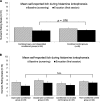Antipruritic Placebo Effects by Conditioning H1-antihistamine
- PMID: 31490841
- PMCID: PMC6844655
- DOI: 10.1097/PSY.0000000000000743
Antipruritic Placebo Effects by Conditioning H1-antihistamine
Abstract
Objective: Allergic rhinitis symptoms can be reduced by behaviorally conditioning antihistamine. It is unclear whether these findings extend to histamine-induced itch or work when participants are informed about the conditioning procedure (open-label conditioning). The current study aims to investigate the efficacy of (open-label) antipruritic behavioral conditioning for histamine-induced itch.
Methods: Healthy participants (n = 92; 84% female) were randomized to I) an open-label conditioned, II) closed-label conditioned, III) conditioned-not-evoked control, or IV) nonconditioned control group. A two-phase conditioning paradigm was used. During acquisition, a conditioned stimulus (CS; distinctively tasting beverage) was repeatedly paired with the H1-antihistamine levocetirizine (groups I-III). During evocation, the CS was paired with placebo (I, II), or instead of the CS, water was paired with placebo (III). The nonconditioned control group (IV) received CS with placebo in both phases. Itch after histamine iontophoresis and physiological data (i.e., spirometry, heart rate, skin conductance) were assessed. Combined conditioned and combined control groups were first compared, and analyses were repeated for separate groups.
Results: Marginally lower itch was reported in the combined conditioned compared with the control groups (F(1,88) = 2.10, p = .076, ηpartial = 0.02); no differences between separate groups were found. No effects on physiological data were found, except for heart rate, which reduced significantly and consistently for control groups, and less consistently for conditioned groups (group by time interaction: F(7,80) = 2.35, p = .031, ηpartial = 0.17).
Conclusion: Limited support was found for the efficacy of antipruritic behavioral conditioning, regardless of whether participants were informed about the conditioning procedure. The application of open-label conditioning in patient populations should be further researched.
Trial registration: www.trialregister.nl; ID NTR5544.
Figures




Similar articles
-
Behavioral conditioning of antihistamine effects in patients with allergic rhinitis.Psychother Psychosom. 2008;77(4):227-34. doi: 10.1159/000126074. Epub 2008 Apr 16. Psychother Psychosom. 2008. PMID: 18418029 Clinical Trial.
-
Evaluation of the antihistamine effects of olopatadine and levocetirizine during a 24-h period: a double-blind, randomized, cross-over, placebo-controlled comparison in skin responses induced by histamine iontophoresis.J Dermatol. 2013 Dec;40(12):987-92. doi: 10.1111/1346-8138.12326. Epub 2013 Dec 4. J Dermatol. 2013. PMID: 24303975 Clinical Trial.
-
Targeted Use of Placebo Effects Decreases Experimental Itch in Atopic Dermatitis Patients: A Randomized Controlled Trial.Clin Pharmacol Ther. 2021 Aug;110(2):486-497. doi: 10.1002/cpt.2276. Epub 2021 May 25. Clin Pharmacol Ther. 2021. PMID: 33894061 Clinical Trial.
-
Levocetirizine for the treatment of allergic rhinitis and chronic idiopathic urticaria in adults and children.Clin Ther. 2009 Aug;31(8):1664-87. doi: 10.1016/j.clinthera.2009.08.015. Clin Ther. 2009. PMID: 19808127 Review.
-
Recent studies of cutaneous nociception in atopic and non-atopic subjects.J Dermatol. 1999 Feb;26(2):77-86. doi: 10.1111/j.1346-8138.1999.tb03516.x. J Dermatol. 1999. PMID: 10091477 Review.
Cited by
-
[The effect of treatment expectations on pruritus and skin pain].Schmerz. 2022 Jun;36(3):189-195. doi: 10.1007/s00482-021-00600-2. Epub 2021 Oct 27. Schmerz. 2022. PMID: 34705119 Free PMC article. Review. German.
-
Counterconditioning as Treatment to Reduce Nocebo Effects in Persistent Physical Symptoms: Treatment Protocol and Study Design.Front Psychol. 2022 Jun 13;13:806409. doi: 10.3389/fpsyg.2022.806409. eCollection 2022. Front Psychol. 2022. PMID: 35774946 Free PMC article.
References
-
- Bartels DJP, van Laarhoven AIM, van de Kerkhof PCM, Evers AWM. Placebo and nocebo effects on itch: effects, mechanisms, and predictors. Eur J Pain 2016;20:8–13. - PubMed
-
- Sölle A, Bartholomäus T, Worm M, Klinger R. How to psychologically minimize scratching impulses. Z Psychol 2014;222:140–7.
Publication types
MeSH terms
Substances
Associated data
LinkOut - more resources
Full Text Sources
Medical
Research Materials
Miscellaneous

